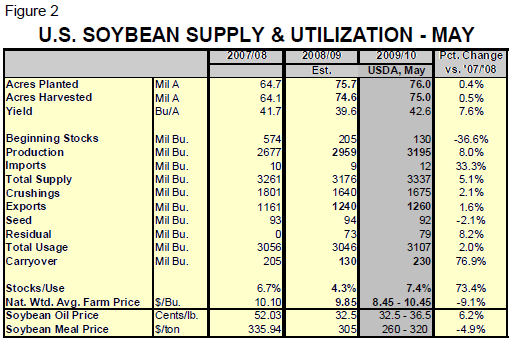



CME: Highlights from Latest USDA Reports
US - CME's Daily Livestock Report for 12 May 2009 reports that USDA took its first official stab at estimating 2009 crops and 2009-2010 crop year usage in the May Crop Production report and World Agricultural Supply and Demand Estimates (WASDE).The report was viewed as neutral for beans and bullish for corn — a sentiment that played out in CME Group grain futures today where corn contracts were 6 to 8 cents/bushel higher and soybeans were anywhere from 7- 1/2 higher on the nearby May to 3-1/2 lower on the new crop November beans. Soybean meal was mixed while soybean oil was 10-11 cents/cwt higher. USDA’s final estimates for 2008-09 supply and utilization as well as this first estimate of 2009-10 supply and utilization for both corn and soybeans are shown below. Some of the report’s highlights are:


- Indications of early concern about the pace of planting. While they did not change planted acres from the level published in the 31 March Prospective Plantings report, USDA did use an average yield of 155.4 bushels per acre, a number slightly lower than the long-term trend yield for this year. We presume that a 6-10 day precipitation forecast that indicates less moisture for Illinois, Indiana, Ohio and Michigan is a contributor to that conclusion but we wonder if that is enough time to get soggy fields dried and planted. Apparently the Feds think it is. Informa Economics said yesterday that it expects corn acres to fall 1.1 million short of the USDA forecast.
- Lower-than-expected South American crops that have left old crop soybeans particularly tight. US ending inventories are expected to be 130 million bushels, putting the year-end stocks/use ratio at 4.3 per cent. Note that USDA’s $9.85 for the national weighted average farm price is all-but fixed from this point on, regardless of what soybeans do this summer. May and July futures are now firmly above $11/bu. and are trending higher as the market rations that tight supply to year-end.

- Apparent conclusions that corn demand has weakened some from 2008 and that soybean demand has remained strong. The scatter diagrams at right show the stocks/use vs. price points back to 1990 for both corn and soybeans. Note that the 2009 corn observation, based on today’s report is significantly below the line that passed very near the 2007 and 2008 observations. This conclusion makes sense in spite of a high need for corn to feed people, livestock and biofuels production because of lower oil prices and a resulting lower ability for ethanol plants to pay as much for corn. If oil prices continue to rise (November ‘09 and May ‘10 crude futures have gained roughly $15/bbl since 1 March), expect this corn price forecast to increase as well. Even though ethanol plants are not particularly profitable at present, they operate in a very competitive market and will likely bid away higher ethanol prices in pursuit of corn. The forecast soybean stocks/use and price combination is right in the hypothetical demand curve that runs through the 2008 solution. This market, of course, is not nearly as sensitive to non-food usage, especially with the disadvantageous cost position of biodiesel relative to petroleum-based diesel fuel.












